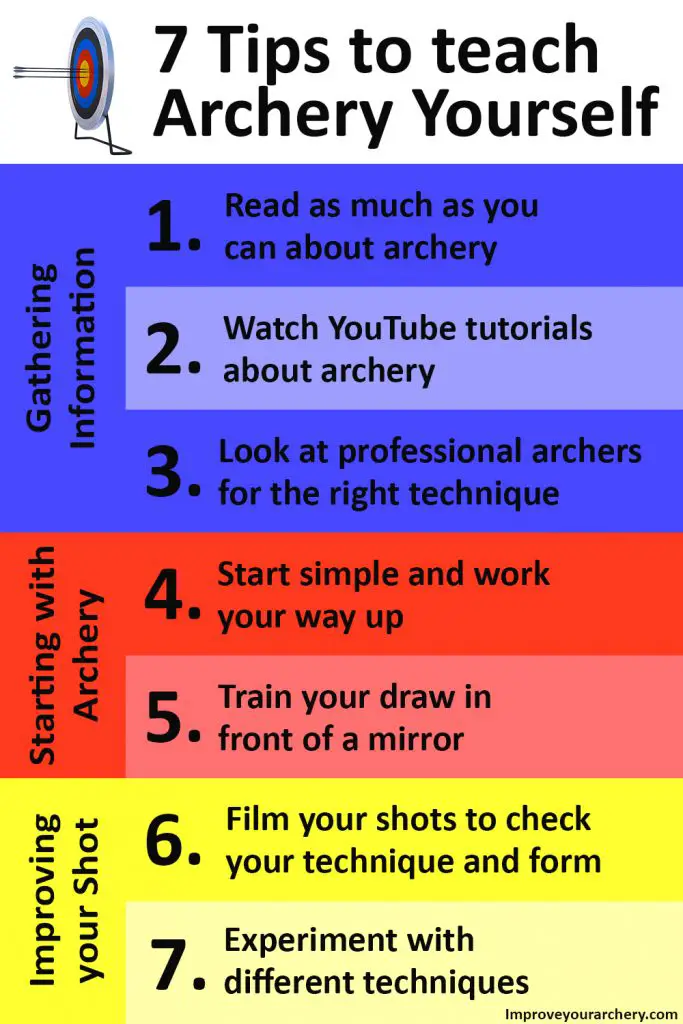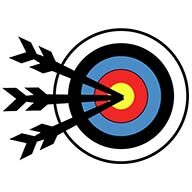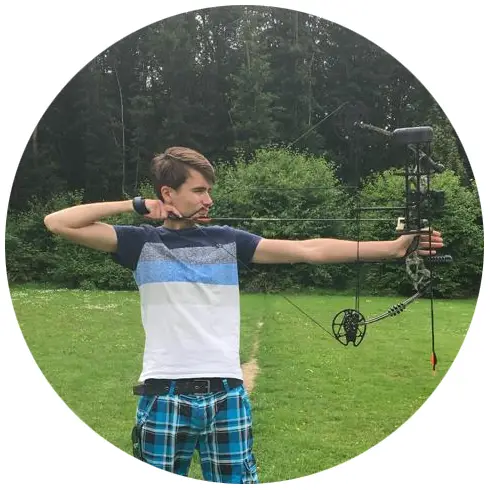One of the big advantages archery has over other sports is that you can shoot completely by yourself. Don’t get me wrong I like to shoot and meet fellow archers, but it is so nice to sometimes just be alone on the field. If you are like me you probably want to teach archery yourself and want some tips on how to do so. Let’s face it, archery is a tough sport. Although it seems simple when you are just starting, you quickly learn that there is more to it than just shooting the arrow. There are so many things that you should take into account, for example: the release, your stance, and the adjustment of your bow.
Even if you have a coach I believe that this article is helpful because you shouldn’t rely purely on someone’s tips. Only the shooter has the whole experience of the shot and can analyze what happens, therefore I believe every archer has to teach himself archery. A coach gives you advice and helpful tips, but you still have to find out what works yourself. Sadly there is not one solution for each archer. There are a lot of discussions between archers about different techniques. Therefore archery tends to be quite a science. In this article, I will give you 7 tips to become an archery scientist.

1. Read in on archery
If you want to learn archery by yourself you need to know at least the basics of archery. You need to know how to tune the bow, what techniques to use and how to advance in archery. Figuring this out by yourself will take a long time, can get frustrating and expensive. Therefore before you start to teach yourself archery, you should know as much as possible. This gives you a head start and will help you in the long run. If you have learned the wrong techniques it can cripple your further development in archery. Therefore I wouldn’t get all your information from one source. The best idea is to have multiple sources and compare their arguments.
For starting archers buying a book with the basics of archery is probably the best start. This is often the easiest and fasted way to get yourself familiar with the most basic principles. Once you are more knowledgeable you might have questions, luckily a lot of archery bloggers have you covered. With a quick Google search, most questions will be answered. Another great resource are archery forums, by far the biggest being ArcheryTalk.com. You can also check out this website for in-depth articles on archery.
2. Watch YouTube tutorials
According to the learning pyramid we retain about 10% of all knowledge that we read, but remember about 20% of what we see and hear. Whether this is true or not, watching tutorials about archery can be really helpful. One of the major channels that have a lot of tutorials and informative videos about archery is NuSensei. But also on YouTube, you can search for different keywords like: ‘’how to tune a recurve bow’’ or ‘’how to train your release’’. You will find that a lot of fellow archers have made very helpful video’s about these subjects.
3. Look at other archers shooting
Looking at other archers can be a great example of what form and techniques are used in archery. You shouldn’t rely solely on copying other archers’ techniques, because specific techniques do not always work for all archers. But looking at other archers can inspire you to try out different techniques. I found, for example, that I had a different grip on the string than is often used by recurve archers. When I tried the technique that almost all archers are using, my scores improved dramatically. Therefore looking at other professional archers can be used as a blueprint. From that basis, you can try different techniques and find the techniques that work best for you.
4. Start simple
A common pitfall of starting archers is to complicate the shot process early on. Many archers want to shoot exactly like the archers in the Olympics and go to great lengths to do so. This is a bad idea because these archers have the experience that a starting archer lacks. If you start to shoot with a clicker immediately learning archery will become really hard.
For first-time archers, I would recommend shooting at least the first few sessions without a sight and stabilizers. In the first sessions, you just need to experience how the bow feels and get used to the draw weight. By going back to basics you can also focus on your stance and overall form.
If you want to eventually shoot the Olympic recurve style, you can slowly add the aids to your bow. I would begin by adding the sight because this is the major determinant for Olympic recurve archery. If you can’t get used to the sight, you better switch to traditional archery.
5. Train without an arrow
No, I am not suggesting you dryfiring a bow, that is a bad idea for many reasons. If you want to train without an arrow you should always slowly relax the bow afterward. A major advantage of training your draw without an arrow is that you can completely focus on your form and stance.
Most archers are very concerned about how accurate they are shooting. That is logical of course since that is the main purpose of archery. But this can also create a side effect. Since you always want to shoot as accurately as possible you focus too much on the arrow and not enough on your form. Training without an arrow can greatly help you to find and train to use the right form.
If you want to check your form, you can always use a mirror. You shouldn’t however only train with a mirror. When you are on the field, you will not have the luxury to check the form on the field. Therefore it’s a good idea to practice while looking forward and only look in the mirror when at full draw. This way you won’t rely on the mirror with the draw, but you will still see if your form is correct.
6. Film yourself, and check your stance
This idea is similar to the previous tip, but the advantage of filming yourself is that you can still shoot. In the previous tip, I mentioned that actually shooting a bow with an arrow takes more concentration, than when training without an arrow. Therefore even if you have trained a lot without an arrow, you might make mistakes in your form. If you film yourself, you can’t check your stance while shooting, which is more realistic.
The advantage is that you can compare the different shots and see if you are consistent and identify problems. Because you can look at the footage back a few times you can really analyze what went right and wrong. If you have a decent camera, you can even film the flight pattern of the arrow. This can help you tune the bow and give you pointers on optimizing your shot.
7. Experiment with different techniques
When you are shooting, you want to shoot the best you can. Therefore many archers are reluctant to change their current techniques. Because you often have to get used to these new techniques, your scores will most often drop. Archery coaches often encourage slowly experimenting with some techniques. You might find that one technique works better for you than you are currently using.
You shouldn’t, however, switch techniques every day, because you have to get used to new techniques before you really know if it works for you. Don’t work on different techniques at the same time, to properly train a technique you need to only focus on one aspect. If you are working on different techniques at the same time, you can’t also attribute the increase or decrease in accuracy to the technique.
Can I teach archery myself?
In general, I think everyone is able to teach him/herself archery, but not everyone wants to. Most people like to get help and don’t like to analyze their shots completely by themselves. Especially if you get frustrated, you might want to seek the help of a coach. If you are not a member of an archery club, you could always consider a (refresher) course for archery. These courses are often open for starting archers and non-members. There are even a few private companies that offer archery courses.
I believe every archer should also focus on their own training and not fully rely on a coach. Only repeating the tips of a coach is often not helpful. You should also deepen your archery knowledge because only you have the complete experience in the shot. Only you can feel if there is extensive vibration in the bow, or if the shot feels different than normal. Therefore for optimal results, you should also be educated on archery.
Final words
If you have any questions please leave them in the comment section down below. If you have any tips you would like to share please do so. I might add them to this article if it fits. I would like this article to be a resource for archers that want to train themselves, so any feedback is helpful.
Tim van Rooijen
For as long as I can remember, I have always been fascinated by archery. First due to its historic significance but later because I like being outdoors. With this blog, I share my knowledge about Archery and how you can improve your shot. More about author…

